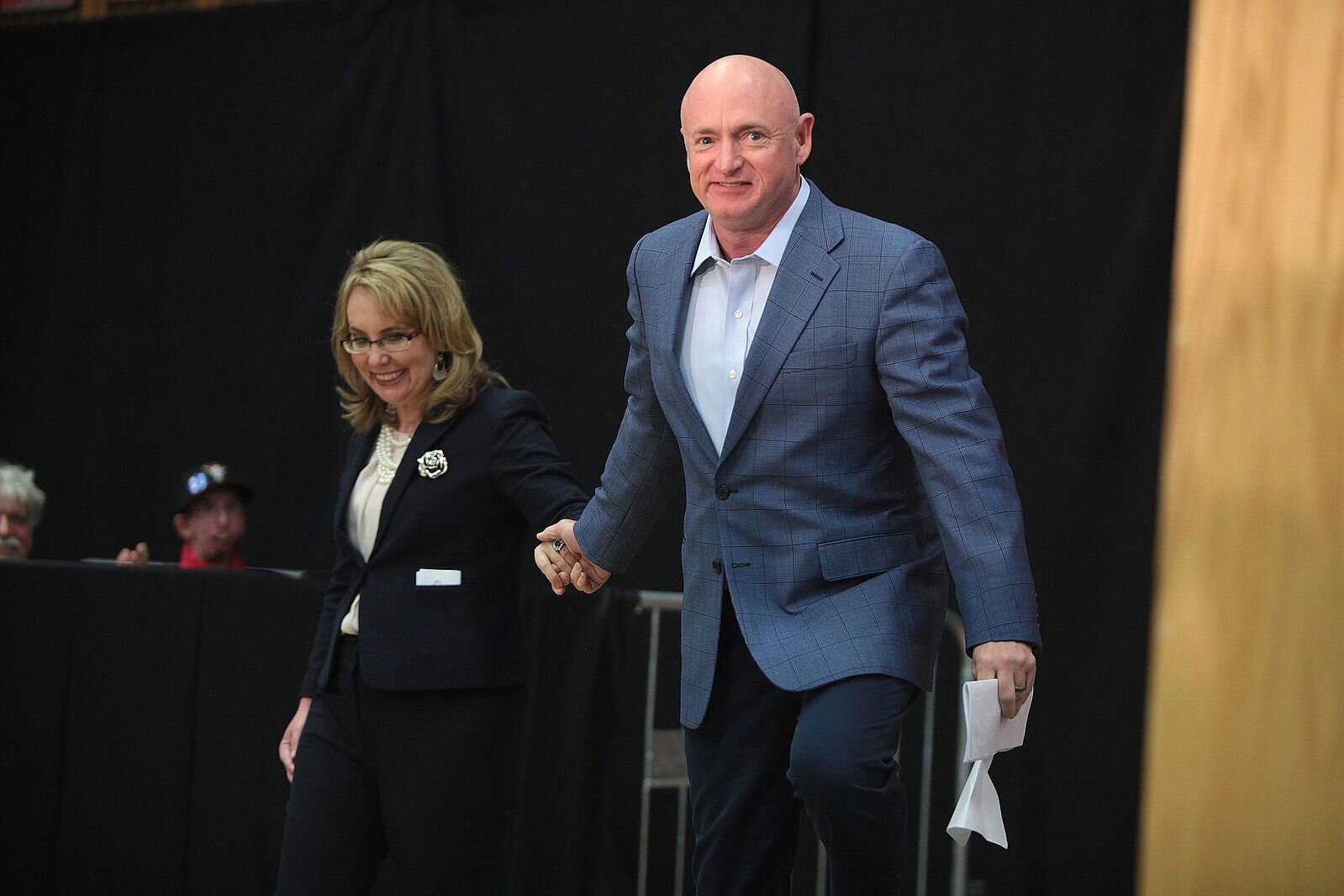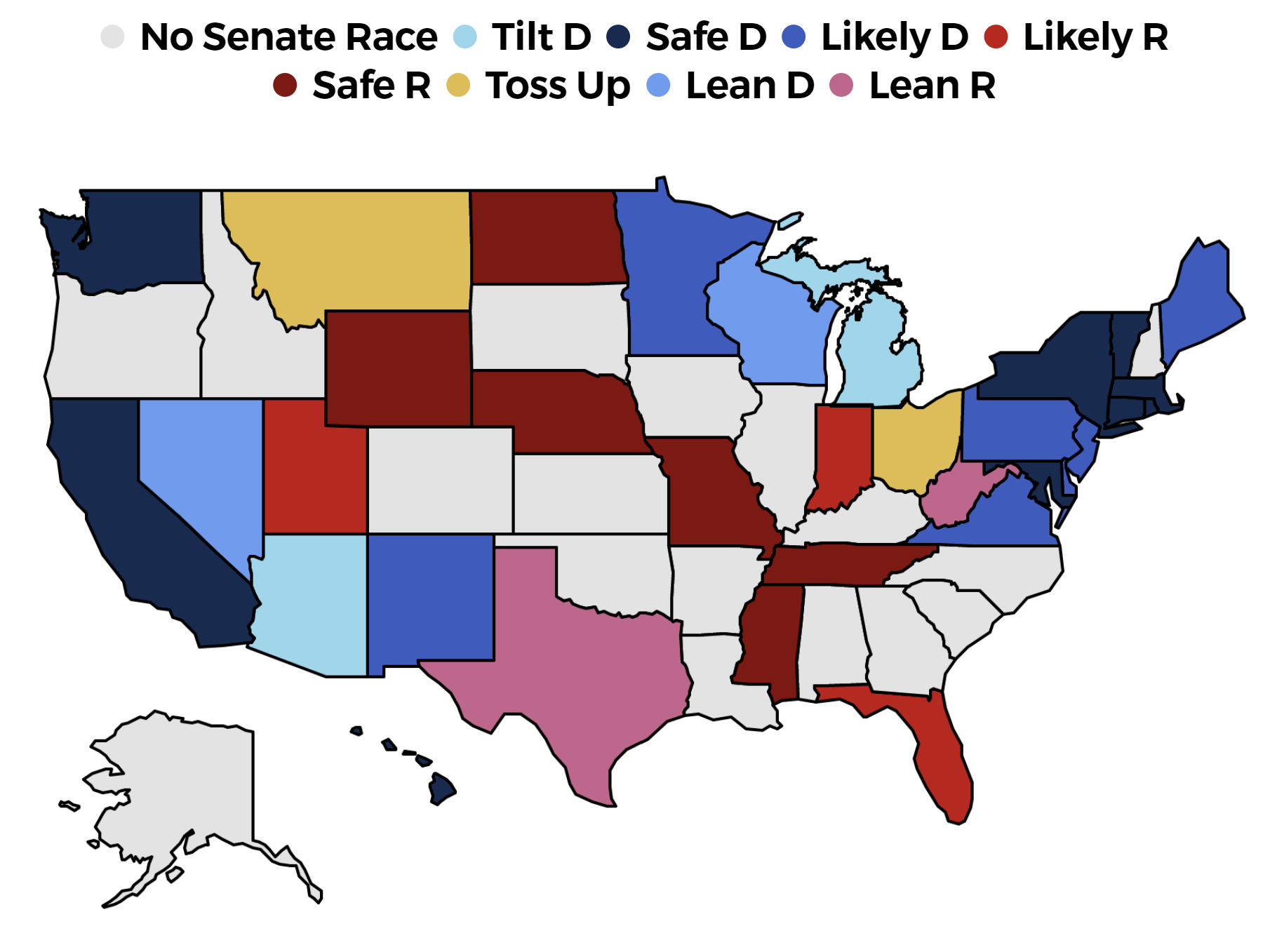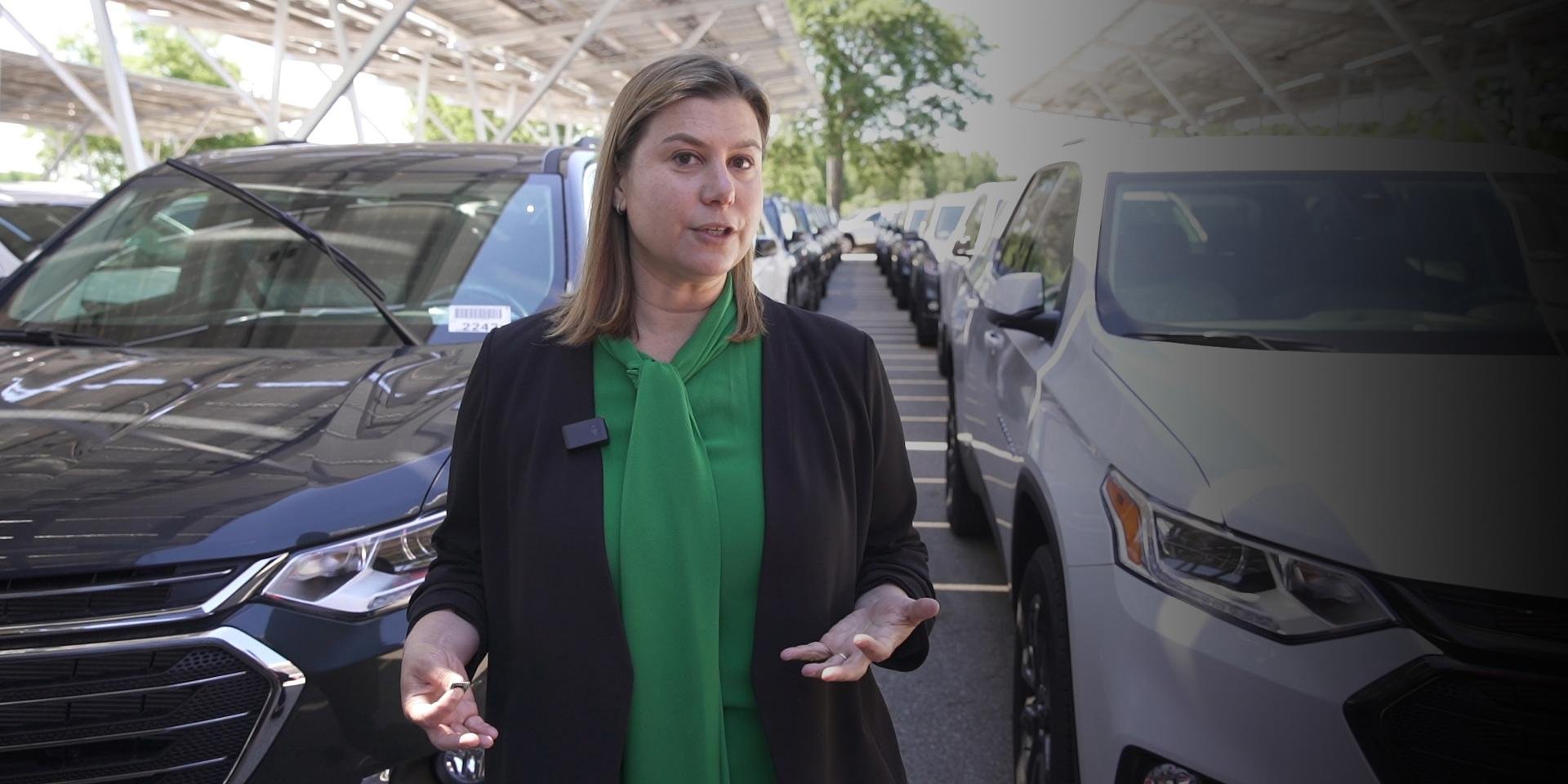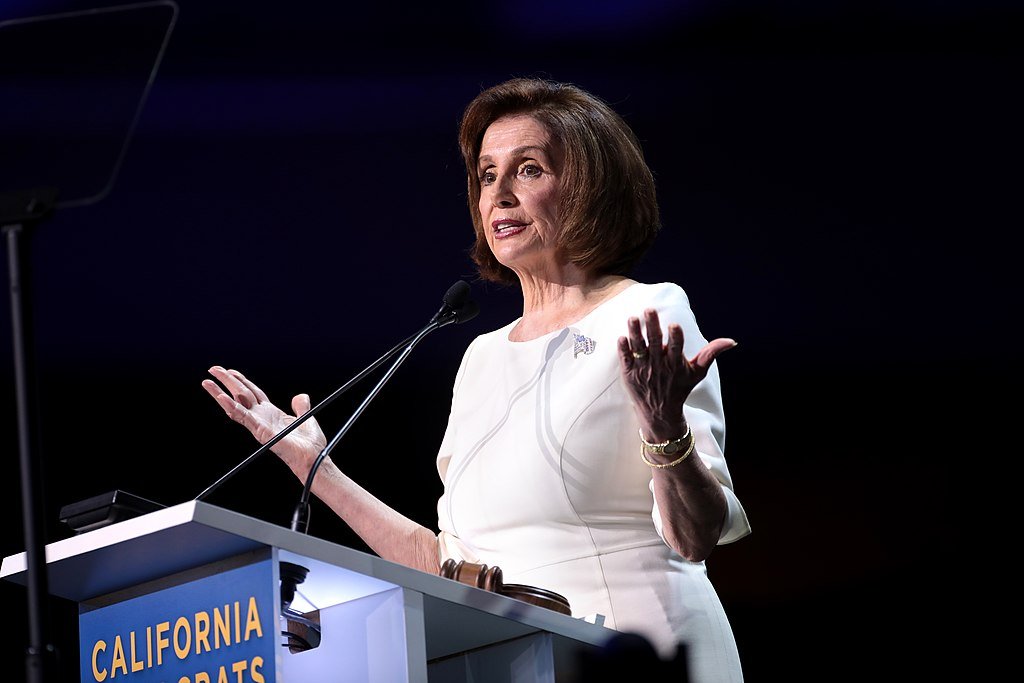The Six Seats Democrats Need to Win to Take the Senate
Astronaut Mark Kelly and his wife, former Congresswoman Gabby Giffords. Photo Credit: Gage Skidmore from Peoria, AZ, United States of America / CC BY-SA (https://creativecommons.org/licenses/by-sa/2.0)
This is Part Three of the Six Part Definitive Guide to the 2020 Senate. Make sure you catch the next part by bookmarking racetothewh.com, or following us on Instagram, Facebook and Twitter
Schedule:
Sunday: The Big Picture - Part One
Monday: The Democratic Pathway to Victory
Tuesday: The Republican Pathway to Victory
Thursday: Where Democrats have the Edge - Part Four
Friday: The True Tossup States - Part Five
Monday: Races with Republicans Out Front - Part Six
By: Logan Phillips
Date: September 10th
As we broke down in the Essential Guide to how Democrats Can Win the Senate, one of the most important keys for the Democrat party to win the Senate is to execute and lock down the races where they have the clear advantage. When they win five of these six races, they end up victorious in 86% of our 50,000 simulations for the Senate forecast. When they win four, they only win 30% of the time.
In Maine and North Carolina, the Democrat’s edge advantage is far more modest, races we have classified as Tilt Democrat. In Arizona, Colorado, Michigan and Minnesota, Democrats are the clear favorites, races classified as Likely Democrat.
You can explore our projections and learn more about these races, and every senate race, in our Senate Race Forecast. It’s updated daily with the latest polls, and every graphic but one in this article was taken directly from this interactive.
1. Arizona
The Democrat: Astronaut Mark Kelly
Mark Kelly was one of the nation’s most prominent astronauts, and has taken four trips to the International Space Station and traveled over 16 million miles around the earth
His passion was science and space – the politics he left to his wife, Congresswomen Gabbi Giffords. However, everything changed when she was shot and almost killed in a horrific mass shooting in Tucson, Arizona.
Kelly instantly rose to national prominence – initially as the loving husband that gave up his career and stood by her side as she made the long road to recovery. As she started to regain her ability to speak, the pair traveled the country as a voice for moderate, common sense gun safety laws that could stem the tide of America’s mass shooting epidemic.
The Republican: Senator Martha McSally
Martha McSally at her 2018 Senate Kickoff. Photo Credit:Gage Skidmore from Peoria, AZ, United States of America / CC BY-SA (https://creativecommons.org/licenses/by-sa/2.0)
Martha McSally was a trailblazer in the military. She’s the first women in American history to fly in combat for the Air Force.
She decided to run for Congresswomen Gifford’s seat in 2012. McSally lost, the first time she ran in 2012, but won two years later in 2014.
McSally hopes history will repeat itself, as she was unsuccessful in her first try for the Senate in 2018, losing by 2% to Kyrsten Sinema. Despite losing the election, Arizona Governor Doug Ducey surprisingly decided to nominate her to the Senate after John McCain passed away.
Senate Forecast
Explore the Senate Forecast, updated daily with new polls, to see which party is the favorite to take the majority.
The State of the Race:
Chance of Winning: Kelly (D) 87%, McSally (R) 13%
Polling: Kelly +9.6%
Net Approval Rating: Kelly +16%, McSally -7%
Fundraising: Kelly +$18 Million
Partisan Lean of Arizona: +6.1% Republican
In January, this race was a tossup, but Kelly began rocket ahead of McSally beginning in March. He smashed records for the largest amount of money raised by a challenger in a Senate Race, and used his advantage to air profile building ads in early 2020.
Once Arizonans began to hear his story, Kelly broke away from McSally and hasn’t’ looked back since.
In our current era of hyper-partisan politics, split-ticket voting has become a lot more unusual. However, a Fox News poll showed Kelly winning 14% of Republicans. More importantly, he is crushing McSally with self-described moderates, winning them 64% to 26%.
This race is very much Kelly’s to lose. In an effort to bring his poll numbers back down to earth, McSally has launched several attacks in the past two months that have begun to stray pretty far from the truth. She criticized Kelly for profiting off of tax payer money during the coronavirus. While its true that Kelly started a high-tech company seven years ago that applied for a small business loans this summer, Kelly had cut all financial ties the company in February of 2019 before announcing his bid for Senate.
She also accused Kelly of supporting defunding the police - but he’s never endorsed that position.
2. Michigan
The Democrat: Senator Gary Peters
Gary Peters joined the Navy Reserve late in life, as a 34-year-old State Senator. Even while working as a legislator, he served two tours in the Persian Gulf both before and after 9/11.
Peters ran for office in 2008 in the midst of the economic crisis, which threatened to crush the auto industry and Michigan’s economy. Peters played a pivotal role in Congress putting together a bailout that helped save auto companies from disaster. Undoubtedly, this achievement came in handy in 2014, when Peters ran for the Senate and won by 13%
Most Senators love talking to the press and building a national profile, but you’ll rarely find Peters in front of the camera. He’s more of a policy wonk, and the type of legislator who prefers to do his work behind close doors. While this level of seriousness has endeared him to many Michiganders, its probably part of the reason why his fundraising totals are lower than expected
The Republican: Businessman John James
John James served his country with distinction in the Air Force as an apache combat helicopter pilot in Operation Iraqi Freedom. When he came back home, he took over the family business.
In 2018, James ran against popular long-time incumbent Senator Debbie Stabenow, and looked primed for an 11% blowout. However, James significantly outperformed expectations and only lost by 6%.
James would be the second Black Senator for the GOP in 50 years - both an important historic and political distinction. Donald Trump’s rhetoric and racial politics has not exactly endeared him to the African American community and has cost Republicans support in the suburbs.
Republicans hope James’s willingness to be candid about the state of racism in America will help him outperform President Trump with these groups. James said on the campaign trail, “I know what it feels like to be pulled over and fear for my life and wonder if this is the day that my son is going to see his daddy bleed out in the street, James said. “I know what it feels like to be in a car with my wife when somebody calls the cops because they perceive me as a threat."
The State of the Race:
Chance of Winning: Peters (D) 81%, James (R) 19%
Polling: Peters +6.4%
Net Approval Rating: Peters +10.0%, James -3.0%
Fundraising: Peters +$2.2 Million
Partisan Lean of Michigan: +0.9% Republican
James is down by a fair amount, (6-7%), but he has narrowed the gap from 12%. He’s also the only Republican to have out fundraised a sitting Democrat incumbent
One thing to keep an eye on – there have been a surprisingly high number of big polling misses in Michigan in recent years. While James is clearly the underdog, his chances are probably higher then the 19% chance we give him.
John James’s pathway to victory is being seriously complicated by Donald Trump. Trump is more unpopular in Michigan (42% approve, 55% disapprove) than any other swing state, and seriously damaged his brand by making a series of remarkable Michigan specific unforced errors, like threatening to cut off all ventilators and aid if Governor Gretchen Whitmer didn’t start saying nicer things about him. It’s unclear whether this is a hurdle James will be able to overcome.
3. Colorado:
The Republican: Senator Cory Gardner
Photo Credit: Gage Skidmore from Peoria, AZ, United States of America / CC BY-SA (https://creativecommons.org/licenses/by-sa/2.0)
Cory Gardner grew up in Yuma, Colorado, and worked in the farm equipment business. He won election in 2014 against incumbent Mark Udall
Gardner likes to style himself as a bipartisan dealmaker, but that’s a hard profile to build at a time when there doesn’t seem to be any deals to be made. It’s not for lack of effort – one group ranked Gardner as the third most bipartisan Senator in the nation.
Gardner had hoped to have a breakthrough in the Senate on marijuana legislation. The decision to legalize remains very popular in Colorado, and the pot industry has become a boon to the state’s economy.
However, Mitch McConnell is an ardent anti-marijuana hawk, and shut down any possibility of a bipartisan compromise, denying Gardner a much-needed win. Frankly, it probably cost Gardner an endorsement from the Marijuana industry as well, as it became increasingly clear that no reform will pass the Senate so long as McConnell remains Majority Leader.
The Democrat: Governor John Hickenlooper
Photo Credit: Gage Skidmore from Peoria, AZ, United States of America / CC BY-SA (https://creativecommons.org/licenses/by-sa/2.0)
Hickenlooper is an unconventional politician, known more for his quirkiness then his charisma. That’s not necessarily a bad thing – he’s authentic, and he’s got a record as a bipartisan dealmaker as Governor. He’s largely shied away from the partisan warfare that has dominated much of the political landscape in recent years
Speaking of unconventional, Hickenlooper started out his career as a geologist, but when he was laid off, he made the first of two dramatic career changes. He was passionate about beer, so he opened up Colorado’s first brewpub, which became a big hit. In 2003, he shifted gears again and ran for Mayor of Denver, winning in a landslide. He then ran for Governor in 2010.
The State of the Race:
Chance of Winning: Hickenlooper (D) 85%, Gardner (R) 15%
Polling: Hickenlooper +8.0%
Net Approval Rating: Hickenlooper +5%, Gardner -12%
Fundraising: Hickenlooper +$2.3 Million
Partisan Lean of Colorado: +2.5% Democrat
The political environment in the Centennial State has shifted significantly to the left since Gardner won his seat in 2014 by two points. White college educated and suburban voters have been shifting away from the GOP and towards the Democratic party, a trend that has only been accelerated by the Trump Presidency. His approval rating is abysmal in Colorado, and his unpopularity has been an anchor around Gardner’s neck.
The one piece of good news for Gardner is the race has gotten closer. The bad news is that Hickenlooper would still win the election in a landslide if it were held tomorrow.
Hickenlooper’s net approval (approval-disapproval) rating took a hit in the primary, falling from +14% to just +5%. That’s probably what has made this race more competitive.
4. Minnesota
Photo Credit: Minnesota Democratic-Farmer-Labor Party / CC BY-SA (https://creativecommons.org/licenses/by-sa/2.0)
The Democrat: Senator Tina Smith
Tina Smith used to be a small business owner, and her first job in politics was as a manager of Ted Mondale’s unsuccessful run for Governor in 1998. She later worked for Planned Parenthood.
Smith was hired as Governor Mark Dayton’s Chief of Staff, and four years later Dayton asked her to run with him in 2014 as Lieutenant Governor. In 2018, Dayton nominated Smith as Franken’s replacement.
During her tenure in the Senate, Smith has carved out a profile as a moderate dealmaker, especially on health care. She helped write a successful bill to expand funding for Americans suffering from opioid addiction, which was signed into law by President Trump.
The Republican: Congressman Jason Lewis
Jason Lewis is a former political radio host who ran for office in 2016 fully embracing Donald Trump and winning one of the toughest house elections in the Midwest. However, Lewis lost re-election just two years later.
Lewis has gone all in on negative campaigning and has launched some eyebrow raising attacks on Tina Smith. In one advertisement, Lewis’s team features violent imagery and fire is shown on the screen while the announcer says, “They burned a police station, but Tina Smith supports the radical defund the police movement.” Now to be clear, Lewis is pulling this attack of thin air - Smith has never endorsed defunding the police.
Lewis has also tried to characterize Smith as a “radical socialist”, which is also inaccurate
It’s very clear what Jason Lewis is running against. Much less clear is what if any policies Lewis actually supports. After going through dozens of Facebook post, many recent interviews, and his entire campaign website, there was practically no mention of a single policy or position that he endorses. Almost all of it were attacks on his opponent.
The State of the Race:
Chance of Winning: Smith (D) 89%, Lewis (R) 11%
Polling: Smith +7.7%
Net Approval Rating: Smith +13%, Lewis +1%
Fundraising: Smith +$5.3 Million
Partisan Lean of Minnesota: +1.4% Democrat
The chasm between the way these two campaigns have decided to approach the election could not be any wider. Smith’s campaign is emphasizing her empathy, her ability to listen to voters, and her record as a dealmaker in Congress.
In contrast, Lewis’s attacks on Smith are exceptionally dark. His mission: Run against campaign positions that Tina Smith has never held and try to make her look like a wide-eyed radical bent on endangering the good people of Minnesota. He’s been unleashing a barrage of these type of attacks on Facebook, where he’s outspent Smith 3-1.
Frankly, it’s a little much, and it’s probably not the ideal strategy. This type of over-caffeinated rhetoric turns off many persuadable voters.
Tina Smith has a big lead in fundraising, so Lewis can’t afford to waste money. He remains unknown with most Minnesotans, and risk having his profile defined for him. It might be wiser to prioritize building his own image instead.
So far, the strategy has not panned out for the former Congressman. Lewis was down by just 3.5% at the beginning of September, but now he’s down by almost 8%.
5. Maine
Photo Credit: Joy Holder, U.S. Senate Photographic Studio / Public domain
The Republican: Senator Susan Collins
The average G.O.P candidate would be facing long odds in a blue leaning state like Maine, but Susan Collins has never been an average Senator. She has consistently trounced her opponents by 15-40% in every election this millennium – attracting significant support from Independents and Democrats alike.
However, Collin’s brand as an independent Senator has taken a pounding over the last four years, and her support with non-Republicans has cratered. Voters think that she has failed to stand up to Donald Trump at his moments of greatest excess. Many left leaning Democrats decided to move on the day she decided to vote for Brett Kavanaugh.
The Democrat: Speaker of the House Sara Gideon
Gideon is the daughter of an Indian immigrant, and the granddaughter of refugees that came to the United States to escape the Armenian genocide.
In 2009, the Maine Democrat party encouraged her husband, Ben, to run for Freeport Town Council, but she decided to run herself instead.
Eleven years later, Gideon went on to spend eight years in the Maine State House of Representatives, and became its Speaker of the House in 2016.
The State of the Race:
Chance of Winning: Gideon (D) 65%, Collins (R) 35%
Polling: Gideon +4%
Net Approval Rating: Gideon +7.6%, Collins -10.7%
Fundraising: Gideon +$10 Million
Partisan Lean of Maine: +4.3% Democrat
This Senate Race has very much become a referendum on Susan Collins. Her approval ratings suggest trouble for the Collins camp. She was the single most popular Republican Senator in their home state back in 2015, with an approval rating of 78%. However, it has since cratered to only 40%.
She’s still only down about four percent in the polls, and many voters remain undecided. If she can convince Mainers that she is still the independent voice they embraced in years past, she can claw her way back to victory.
6. North Carolina
The Republican: Senator Thom Tillis
Photo Credit: https://upload.wikimedia.org/wikipedia/commons/4/49/Thom_Tillis_-_Fayetteville%2C_NC_Rally.jpg
Thom Tillis worked in business before he got into politics. He was a partner for an accounting firm that was sold to IBM, and he continued to work as a top executive there after the sale.
Tillis started out on the local level – winning a race for town commission in Cornelius, North Carolina on a campaign for building a local bike trail. He went on to become a State Representative, and then the Speaker State House.
He passed sweeping tax reform as Speaker, but received criticism for passing a voter id law (which was vetoed by the governor), which many experts argue is intended to make it harder for both African Americans and lower income voters to cast their ballot.
In 2014, Tillis ran for the Senate and beat incumbent Democrat Kay Hagan by a narrow margin of 1.5%. 2014 was a banner year for Republicans, so Tillis will likely need a better performance to win this year, especially if Democrats outperform Republicans by six to eight percent as national polls suggest they might.
The Democrat: State Senator Cal Cunningham
Photo Credit: Graysonbarnette / CC BY-SA
Cal Cunningham worked as both a lawyer and State Senator, and joined the army reserve after 9/11.
After an unsuccessful run for the Senate in 2010, Cunningham became vice president of an environmental organization called Waste Zero, but left the company in March after winning the Democratic Nomination.
Cunningham stunned the political world by more than tripling Tillis in fundraising in the second quarter. He now has raised more than Tillis - a stunning achievement for a challenger this early in the race.
The State of the Race:
Chance of Winning: Cunningham (D) 70%, Tillis (R) 30%
Polling: Cunningham +4.6%
Net Approval Rating: Cunningham +12.2%, Tillis -0.4%
Fundraising: Cunningham +$4.8 Million
Partisan Lean of Maine: +6.3% Republican
For months, this race was a barn burner, but in July, Cunningham burst past Tillis in the polls and took a clear lead. Interestingly, Tillis didn't really lose any support. Instead, Cunningham has been winning undecided voters over in large numbers, both among Democrats and Independents.
Right now, Tillis is stuck in a tough place. Far too many Republican voters remain undecided, in part due to a perception that he hasn't been a strong enough ally to Trump. However, many of the independents who are shifting towards Cunningham feel the opposite and are looking for someone that isn't so tied to the President.
I expect most Republicans voters will reluctantly come around and make this race a bit closer again, although Cunningham has shown a surprising propensity to win over Trump supporters thus far.
The Senate Races























